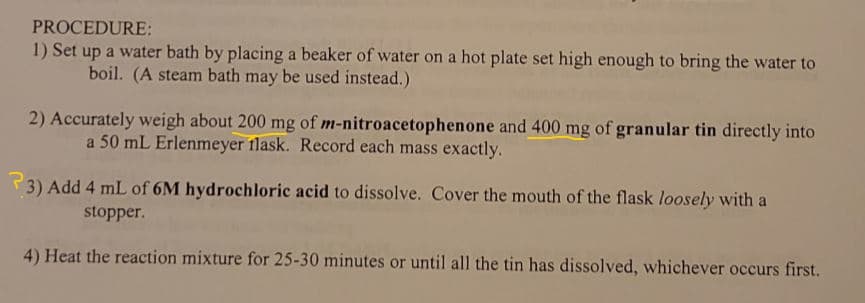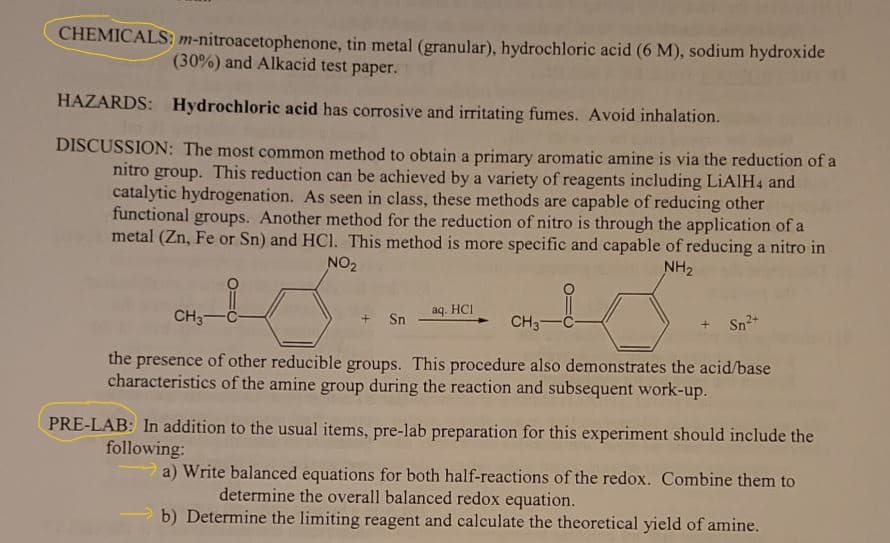Ochem help with prelab The experiment is attached and involves the reduction of a nitro group to an amine The Chemicals are: 200 mg of m-nitroacetophenone 400 mg of granular tin 4 mL of 6M hydrochloric acid 30% sodium hydroxide Need help with the prelab which requires... A. Write the balanced equations for both half-reactions of the redox and then the overall balanced redox equation B. Determine the limiting reagent and the theoretical yield of amine
Ochem help with prelab The experiment is attached and involves the reduction of a nitro group to an amine The Chemicals are: 200 mg of m-nitroacetophenone 400 mg of granular tin 4 mL of 6M hydrochloric acid 30% sodium hydroxide Need help with the prelab which requires... A. Write the balanced equations for both half-reactions of the redox and then the overall balanced redox equation B. Determine the limiting reagent and the theoretical yield of amine
Organic Chemistry
8th Edition
ISBN:9781305580350
Author:William H. Brown, Brent L. Iverson, Eric Anslyn, Christopher S. Foote
Publisher:William H. Brown, Brent L. Iverson, Eric Anslyn, Christopher S. Foote
Chapter18: Functional Derivatives Of Carboxylic Acids
Section: Chapter Questions
Problem 18.42P
Related questions
Question
Ochem help with prelab
The experiment is attached and involves the reduction of a nitro group to an
The Chemicals are:
200 mg of m-nitroacetophenone
400 mg of granular tin
4 mL of 6M hydrochloric acid
30% sodium hydroxide
Need help with the prelab which requires...
A. Write the balanced equations for both half-reactions of the redox and then the overall balanced redox equation
B. Determine the limiting reagent and the theoretical yield of amine

Transcribed Image Text:PROCEDURE:
1) Set up a water bath by placing a beaker of water on a hot plate set high enough to bring the water to
boil. (A steam bath may be used instead.)
2) Accurately weigh about 200 mg of m-nitroacetophenone and 400 mg of granular tin directly into
a 50 mL Erlenmeyer flask. Record each mass exactly.
3) Add 4 mL of 6M hydrochloric acid to dissolve. Cover the mouth of the flask loosely with a
stopper.
4) Heat the reaction mixture for 25-30 minutes or until all the tin has dissolved, whichever occurs first.

Transcribed Image Text:tin metal (granular), hydrochloric acid (6 M), sodium hydroxide
(30%) and Alkacid test paper.
CHEMICALS: m-nitroacetophenone,
HAZARDS: Hydrochloric acid has corrosive and irritating fumes. Avoid inhalation.
DISCUSSION: The most common method to obtain a primary aromatic amine is via the reduction of a
nitro group. This reduction can be achieved by a variety of reagents including LiAlH4 and
catalytic hydrogenation. As seen in class, these methods are capable of reducing other
functional groups. Another method for the reduction of nitro is through the application of a
metal (Zn, Fe or Sn) and HCl. This method is more specific and capable of reducing a nitro in
NO₂
NH₂
aq. HCI
+ Sn
CH3-C-
CH3 C
the presence of other reducible groups. This procedure also demonstrates the acid/base
characteristics of the amine group during the reaction and subsequent work-up.
+ Sn²+
PRE-LAB: In addition to the usual items, pre-lab preparation for this experiment should include the
following:
a) Write balanced equations for both half-reactions of the redox. Combine them to
determine the overall balanced redox equation.
b) Determine the limiting reagent and calculate the theoretical yield of amine.
Expert Solution
This question has been solved!
Explore an expertly crafted, step-by-step solution for a thorough understanding of key concepts.
This is a popular solution!
Trending now
This is a popular solution!
Step by step
Solved in 3 steps with 4 images

Knowledge Booster
Learn more about
Need a deep-dive on the concept behind this application? Look no further. Learn more about this topic, chemistry and related others by exploring similar questions and additional content below.Recommended textbooks for you

Organic Chemistry
Chemistry
ISBN:
9781305580350
Author:
William H. Brown, Brent L. Iverson, Eric Anslyn, Christopher S. Foote
Publisher:
Cengage Learning

Macroscale and Microscale Organic Experiments
Chemistry
ISBN:
9781305577190
Author:
Kenneth L. Williamson, Katherine M. Masters
Publisher:
Brooks Cole

Organic Chemistry: A Guided Inquiry
Chemistry
ISBN:
9780618974122
Author:
Andrei Straumanis
Publisher:
Cengage Learning

Organic Chemistry
Chemistry
ISBN:
9781305580350
Author:
William H. Brown, Brent L. Iverson, Eric Anslyn, Christopher S. Foote
Publisher:
Cengage Learning

Macroscale and Microscale Organic Experiments
Chemistry
ISBN:
9781305577190
Author:
Kenneth L. Williamson, Katherine M. Masters
Publisher:
Brooks Cole

Organic Chemistry: A Guided Inquiry
Chemistry
ISBN:
9780618974122
Author:
Andrei Straumanis
Publisher:
Cengage Learning